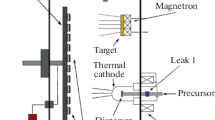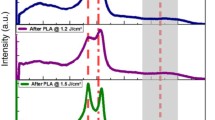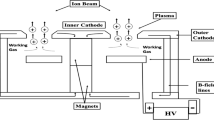Abstract
It is known that diamond-like carbon layers consist of carbon components with sp2 (graphite) and sp3 (diamond) hybridizations of electron orbitals. The quantitative ratio between sp2 and sp3 components has a profound effect on the structural, morphological, optical, electrical, and mechanical properties of the films. In this study, the possibility of controlling the fractions of sp2- and sp3-hybridized carbon in diamond-like films produced by plasma-enhanced chemical-vapor deposition onto single-crystal silicon and diamond substrates is analyzed. In-situ methods of controlling the fraction of the sp3 component by varying the power of the capacitive and inductively coupled discharges directly during production of the film and ex-situ methods, in which use is made of thermal annealing and the application of an electric field, are demonstrated.
Similar content being viewed by others
Avoid common mistakes on your manuscript.
1 INTRODUCTION
At present, diamond electronics is an actively developing field of semiconductor materials science [1]. In the last few years, a substantial breakthrough in the field of diamond microelectronics became evident, which is due to the appearance of single-crystal diamond substrates, whose quality is suitable for electronic applications [2, 3]. In addition, methods for controllably producing high-quality epitaxial p-type single-crystal diamond with specified profiles of boron impurity dopants, using chemical vapor deposition (CVD) [4, 5], were mastered. To create elements of the component base of diamond electronics, it is essential to work out the technologies of the deposition of dielectric coatings and conductive contact layers onto semiconducting diamond. From publications, it is known that the role of dielectric layers can be played by aluminum oxide [6], silicon nitride, zirconium oxide [7], and molybdenum oxide [8]. However, when used together with single-crystal diamond, this group of traditionally used insulators has some limitations associated with poor adhesion, imperfection of interfaces, etc. It has been proposed that, with diamond-like carbon (DLC) films used as coatings on diamond, it is possible to solve the problems with adhesion and defects and contamination at the DLC/diamond interface [9]. In addition, in publications, it was demonstrated that an ultrathin DLC sublayer deposited before the deposition and burning-in of metal contacts offered promise as an intermediate adhesive layer which, at the same time, does not impair the contact resistance [10].
It is known that DLC layers consist of carbon components with sp2-hybridized graphite-type and sp3-hybridized diamond-type electron orbitals [11]. The quantitative ratio between sp2 and sp3 components greatly influences the structural, morphological, tribological, optical, and electrical properties of the films. Of interest is analyzing the possibilities of controlling the ratio between the sp2 and sp3 components and its effect on the physical properties of DLC films deposited onto single-crystal diamond. In this study, we investigate the in-situ- and ex-situ methods of controlling the ratio between the sp2- and sp3-hybridized carbon components in DLC films produced by plasma-enhanced chemical-vapor deposition (PECVD) onto single-crystal diamond and silicon.
2 EXPERIMENTAL
The DLC films were produced by PECVD in methane–argon plasma, using an Oxford Plasmalab 80 Plus setup. The procedure was carried out in a reactor with two plane-parallel electrodes and a source of inductively coupled plasma at a frequency of 13.56 MHz. The films were deposited under the conditions of both capacitive and inductively coupled discharges [9]. For the substrates, we used silicon wafers and homoepitaxial CVD single-crystal diamond layers doped with boron (~1020 cm–3). For the method of in-situ control of the ratio between the sp2- and sp3-hybridized carbon components in DLC films, we proposed variations in the powers of capacitive and inductively coupled discharges.
For the method of ex situ varying the ratio between the sp2- and sp3-hybridized carbon components in DLC films, we used rapid thermal annealing. The structures were annealed in an argon atmosphere at temperatures in the range from 500°C to 900°C for 2 min, using an AcuThermo AW 410 System setup. The properties of the films were characterized using a number of methods, specifically, small-angle X-ray reflectometry (XRR, Bruker D8 Discover), secondary-ion mass spectrometry (SIMS, IonTOF, TOFSIMS-5), atomic-force microscopy (AFM, Proton-MIET SMM-2000), and Raman spectroscopy. To perform quantitative SIMS depth profiling of the fraction of sp3-hybridized carbon, we used a previously developed procedure [12] based on calibration of the mass spectrometer with the use of a test series of samples, for which the fraction of sp3-hybridized carbon is known from X-ray photoelectron spectroscopy (XPS) data.
3 RESULTS AND DISCUSSION
At first, we studied the dependence of the fraction of sp3-hybridized carbon in the DLC films on the conditions of their PECVD deposition. Table 1 lists the characteristics of films deposited onto silicon and diamond at different powers P of capacitive (P(RF)) and inductively coupled plasma (P(ICP)) discharges. The fraction of sp3-hybridized carbon in the films, N(sp3), was determined by the SIMS technique, in accordance with the procedure described in [12]. The typical profile obtained by quantitative SIMS depth profiling of the fraction of sp3-hybridized carbon in a DLC film on diamond is shown in Fig. 1a. For the sample under consideration, the fraction of sp3-hybridized carbon in the film varies in the range of 20–40%, and the average fraction is 30%. Figure 1b shows the typical XRR curve for the same DLC film on diamond. Kiessig’s oscillations appear because of the density contrast between the film and the substrate, since the DLC density is lower than the density of diamond. The results of the XRR experiment are indicative of the formation of a smooth homogeneous carbon film on diamond. The experimental XRR data were processed using DIFFRAC.Leptos software [13]. For the initial model for calculation and fitting of the XRR curve, we took a homogeneous film with a density of ~2 g cm–3 on a carbon substrate with a density of 3.51 g cm–3 (diamond). In the fitting procedure, we varied the following parameters: the film thickness h, the film density ρ, and the widths of the film/substrate and film/air interfaces. The interface width was described with an error function with the characteristic parameter σ. The fitting procedure was conducted by minimizing the logarithmic discrepancy functional by the gradient method. The solid line in Fig. 1b shows the best fit, and the related parameters of the model are given in Table 1. The XRR data for DLC films on silicon were processed in a similar manner. It should be specially noted that the interfaces for DLC on diamond are less smeared compared to those for DLC on silicon. This can be attributed to lesser damage to the diamond substrate at the beginning of deposition of DLC and to less efficient intermixing at the film/substrate interface because of the identity of the substrate and film materials in chemical composition.
The data given in Table 1 show a well-pronounced correlation between the power of RF and ICP discharges and the fraction of sp3-hybridized carbon in the deposited films. An increase in the total power of the discharge in plasma yields an increase in the fraction of sp3-hybridized carbon in the film. In publications, this effect is attributed to the selectivity of plasma etching for sp2-hybridized carbon compared to the sp3-hybridized component [11].
For the method of ex-situ control of the ratio between the sp2- and sp2-hybridized carbon components in DLC films on diamond, it is possible to use rapid thermal annealing. Sample 220 with a DLC film on diamond was subjected to rapid thermal annealing in an argon atmosphere sequentially at the temperatures 500°C, 700°C, and 900°C. Figure 2 shows the Raman spectra for the film at different stages of annealing. It can be seen that, for the initial film (Fig. 2, line 2), we observe a low-intensity broad G peak at about 1535 cm–1, with the full width at half-maximum (FWHM) 260 cm–1. According to publications, this peak is associated with the slightly ordered amorphized carbon phase [11]. The D peak is unobservable, since it is superimposed with a high-intensity peak related to the single-crystal diamond substrate (Fig. 2, line 1). Sequential annealing of the structure induces a sequential shift of the G peak to 1600 cm–1 and a decrease in its FWHM to 120 cm–1. Such result is indicative of ordering of the sp2 component, with the formation of nanocrystalline graphite clusters. According to publications, this is accompanied by a considerable increase in the conductivity of the films [11, 14]. Probe measurement of the conductivity of the films before and after annealing at 900°C show a decrease in the layer resistance by five or six orders of magnitude. These results suggest that DLC sublayers can be used in forming combined metal/DLC contacts to diamond by rapid thermal annealing.
Results of analysis of the 42-nm-thick DLC film 220 deposited by PECVD onto a single-crystal diamond substrate: (a) quantitative SIMS depth profiling of the fraction of sp3 carbon and (b) the XRR curve (symbols 1 refer to the experiment and solid line 2 to the calculation for the model, whose parameters are given in Table 1).
To study the electrical properties of DLC films on single-crystal diamond, we prepared a special test structure. A heavily doped epitaxial diamond layer (with the thickness ~1 μm and the boron impurity concentration ~1020 cm–3) was grown on an undoped single-crystal substrate, and then a 30-nm-thick DLC film was deposited by the PECVD method. To study vertical transport, aluminum metal contacts were deposited onto this film by electron-beam evaporation. Then we conducted two-probe electrical measurements: one probe was pressed against the aluminum contact, and the other against the indium ohmic contact formed to the heavily doped diamond layer. We recorded current–voltage (I–V) characteristics of the structure for several contacts. The measurements were conducted in the voltage range from –20 to +20 V. As the voltage was varied for the first time (0 → –20 V → +20 V → 0), we observed strong hysteresis in the I–V characteristic. After several cycles of variations, the hysteresis was reduced and then, in further measurements, remained practically unchanged. Figure 3 shows the I–V characteristics for one of the aluminum contacts 60 μm in diameter. The arrows indicate the sequence of variations in the voltage during recording of the curve. Reduction of the hysteresis under the action of a high electric field (~10 MV cm–1) is obviously due to irreversible processes in the DLC film. Such a process can be the formation and ordering of conductive nanocrystalline graphite clusters formed by the sp2-hybridized carbon component [14]. In this case, the film transforms into a low-resistance state, and its conductivity irreversibly increases by more than two orders of magnitude, as in the case of rapid thermal annealing.
4 CONCLUSIONS
In the study, the possibility of controlling the relation between the sp2- and sp3-bonded carbon components in PECVD DLC films is demonstrated. The sp2/sp3 ratio can be controlled both in situ, directly during the production of the film, and ex situ, by postgrowth annealing as well as by the application of an electric field. The results obtained in the study show that one can vary the fraction of the sp2 carbon component in the films and, thus, control their structural properties and conductivity. The possibility of producing both insulating DLC coatings (at a high fraction of the sp3 component) and conductive coatings (at a high fraction of the sp2 component) on single-crystal diamond. The approaches demonstrated in the study appear to have promise for the formation of insulating and contact layers on single-crystal semiconducting diamond.
REFERENCES
S. Koizumi, H. Umezawa, J. Pernot, and M. Suzuki, Power Electronics Device Applications of Diamond Semiconductors (Woodhead, Chennai, 2018).
P. A. Yunin, P. V. Volkov, Yu. N. Drozdov, A. V. Koliadin, S. A. Korolev, D. B. Radishchev, E. A. Surovegina, and V. I. Shashkin, Semiconductors 52, 1432 (2018).
P. A. Yunin, Yu. N. Drozdov, V. V. Chernov, V. A. Isaev, S. A. Bogdanov, and A. B. Muchnikov, Semiconductors 50, 1622 (2016).
A. L. Vikharev, A. M. Gorbachev, M. A. Lobaev, A. B. Muchnikov, D. B. Radishev, V. A. Isaev, V. V. Chernov, S. A. Bogdanov, M. N. Drozdov, and J. E. Butler, Phys. Status Solidi RRL 10, 324 (2016).
J. E. Butler, A. L. Vikharev, A. M. Gorbachev, M. A. Lobaev, A. B. Muchnikov, D. B. Radischev, V. A. Isaev, V. V. Chernov, S. A. Bogdanov, M. N. Drozdov, E. V. Demidov, E. A. Surovegina, V. I. Shashkin, A. Davidov, H. Tan, et al., Phys. Status Solidi RRL 11, 1600329 (2017).
T. T. Pham, J. Pernot, G. Perez, D. Eon, E. Gheeraert, and N. Rouger, IEEE Electron Dev. Lett. 38, 1571 (2017).
W. Wang, K. Fu, C. Hu, F. Li, Z. Liu, S. Li, F. Lin, J. Fu, J. Wang, and H. Wang, Diamond Relat. Mater. 69, 237 (2016).
Z. Ren, J. Zhang, J. Zhang, C. Zhang, S. Xu, Y. Li, and Y. Hao, IEEE Electron Dev. Lett. 38, 786 (2017).
A. I. Okhapkin, P. A. Yunin, M. N. Drozdov, S. A. Korolyov, S. A. Kraev, E. A. Arkhipova, E. V. Skorokhodov, P. A. Bushuykin, and V. I. Shashkin, Semiconductors 53, 1203 (2019).
A. Galbiati, S. Lynn, K. Oliver, F. Schirru, T. Nowak, B. Marczewska, J. Duenas, R. Berjillos, I. Martel, and L. Lavergne, IEEE Trans. Nucl. Sci. 56, 1863 (2009).
J. Robertson, Mater. Sci. Eng. R 37, 129 (2002).
M. N. Drozdov, Yu. N. Drozdov, A. I. Okhapkin, P. A. Yunin, O. A. Streletskii, and A. E. Ieshkin, Tech. Phys. Lett. 46, 290 (2020).
Diffrac. Leptos 7. User Manual (Bruker AXS, Karlsruhe, 2009).
A. S. Vedeneev, V. A. Luzanov, and V. V. Rylkov, JETP Lett. 109, 171 (2019).
ACKNOWLEDGMENTS
The study was carried out with the use of equipment of the Multiple-Access Center “Physics and Technology of Microstructures and Nanostructures”, Institute for Physics of Microstructures, Russian Academy of Sciences.
Funding
The study was supported by the President of the Russian Federation, project no. MK-3450.2019.2. The part of the study concerned with the development of the SIMS procedure was supported by the Russian Foundation for Basic Research, project no. 18-02-00565.
Author information
Authors and Affiliations
Corresponding author
Ethics declarations
The authors declare that they have no conflict of interest.
Additional information
Translated by E. Smorgonskaya
Rights and permissions
About this article
Cite this article
Yunin, P.A., Okhapkin, A.I., Drozdov, M.N. et al. Modification of the Ratio between sp2- to sp3-Hybridized Carbon Components in PECVD Diamond-Like Films. Semiconductors 54, 1047–1050 (2020). https://doi.org/10.1134/S1063782620090316
Received:
Revised:
Accepted:
Published:
Issue Date:
DOI: https://doi.org/10.1134/S1063782620090316







